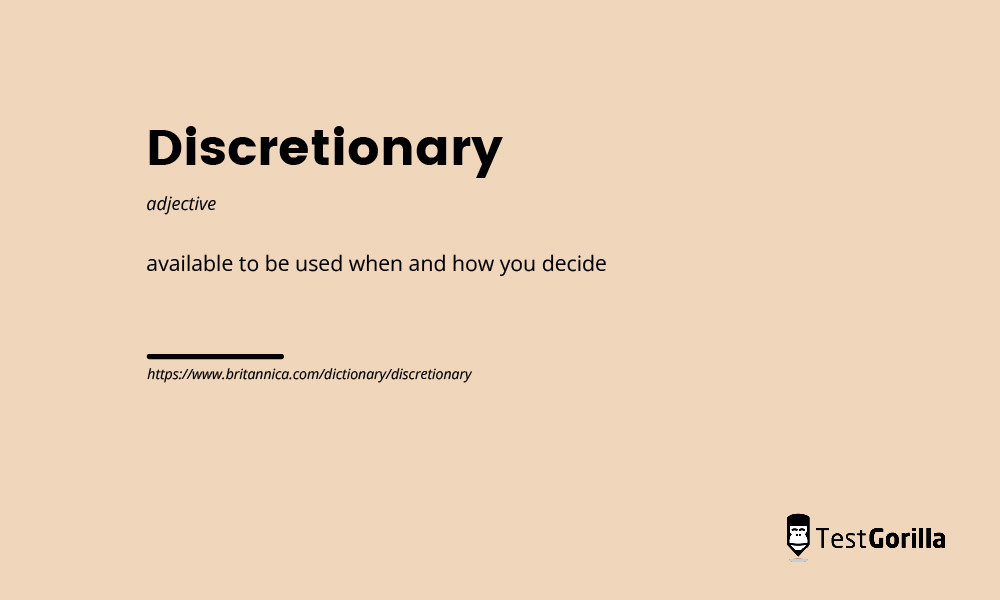You’ve probably heard the term “discretionary effort”. But what does it mean?
It’s a way of measuring the extra work and effort an employee puts in above and beyond what is expected of them.
Have you ever worked for an organization where you didn’t feel inspired, motivated, or happy in your work, and you just did the bare minimum necessary to get by? Many of us have had jobs like this in the past, and were relieved when we got to move on. Why did that happen, and what were those businesses doing wrong in order to make you feel that way?
We’re going to take a closer look at discretionary effort, why it’s important, and how you can inspire and engage your employees.
Why is discretionary effort important?
This kind of effort can also be regarded as employees “going the extra mile” to gain the best possible results. They are happy to work hard to help the business succeed because they feel valued by their managers and coworkers, and know that they are making a difference.
Some employers think that discretionary effort is good to have, but not essential in an employee. However, a company full of clock-watching, disengaged employees won’t perform as well as it could. A lack of discretionary effort can impact an organization’s bottom line as well as leading to constant staff turnover.
Employees who choose to give the maximum amount of effort are always willing to jump in and help other members of the team. They are constantly thinking of ways to improve and streamline work processes, and often come up with great ideas – all without being asked to do so.
They help your business grow because they want to, not because they have to.
Perhaps you are thinking “OK, so discretionary effort is just another way of describing whether an employee is either hard-working or lazy.”
It’s not as simple as that, although this is a mindset many employers can understandably fall into. An individual could do exactly the same job at two different companies, yet give different amounts of discretionary effort at each one.
It’s not a case of laziness or work ethic. It’s about motivation and engagement, and it involves team leaders and managers as well as the employees themselves.
Let’s take a look at the factors behind discretionary effort.
What drives discretionary effort?
Employee engagement and discretionary effort go hand-in-hand. Fully engaged employees willingly give maximum effort, while disengaged ones withhold it.
A recent Gallup survey found that 32 percent of employees working for organizations are engaged, while 17 percent are actively disengaged. The same survey discovered that employee engagement has dropped by two points since 2021, so employee disengagement appears to be a growing trend.
There are several factors that drive discretionary effort:
Job fit: This relates to whether an employee finds their role fulfilling, and if their job description accurately matches the daily duties. Bored and unfulfilled employees soon become disengaged ones.
Manager fit: This factor involves whether or not a staff member feels heard and understood by their manager. Does their manager adjust their leadership style according to the individual employee’s needs?
Team alignment: How well does the employee work within the team dynamics? If they don’t feel psychologically safe to share ideas or feedback with their team members, they won’t be motivated to care about the team.
Culture add: This is often known as “culture fit”, but we prefer to think of it as an individual adding to company culture instead of being made to fit into an existing one. Of course, for them to be engaged they need to feel a connection to the company culture, and their values should align with that of the organization. Our customizable Culture Add test can help you find staff who support your company culture and values.
Ensuring that these factors are met can make all the difference between whether you see minimum effort or discretionary effort from your employees.
The best insights on HR and recruitment, delivered to your inbox.
Biweekly updates. No spam. Unsubscribe any time.
How to inspire discretionary effort
A big paycheck (while nice to have) can’t inspire passion for the job, and no amount of ping-pong tables, pet-friendly offices, or free lunches alone can encourage discretionary effort from employees.
All of these things can help, but the real change must come from the factors we talked about above. Here’s how you can put these ideas into practice and hopefully inspire your employees to go above and beyond the bare minimum.
1. Get to know and understand your team members
How much do you actually know about your team members beyond their role and the day-to-day interactions you have with them about the job?
Getting to know and understand your team members builds a sense of community and connection, which in turn grows trust. You don’t have to be best friends with them, but connecting with your employees on a human level creates a work environment where they know they are heard and valued by management.
Doing this successfully requires more than just small talk or a shared hobby. You need to find out what motivates them and what they care about the most. Having a regular team lunch or get-together where you encourage them to talk about anything except work can help with this.
Remote teams perhaps struggle more with personal connection than office-based ones. If you lead a remote team, you might consider putting extra effort into creating a comfortable environment for everyone to connect on a personal level, such as regular video call socials and one-to-ones.
2. Try to adjust roles to better fit their skills
Adjusting roles to fit an employee’s unique skill set and strengths goes a long way towards a good job fit.
If we don’t enjoy doing our job or find a task boring, we stop caring about it. A 2022 report from Cengage Group found that 83 percent of workers who resigned last year reported feeling stagnant in their role.
Of course, not all roles can be adjusted to make them more interesting, but it might be worth looking into whether some of the more boring, repetitive tasks can be automated or lessened so that the employee can be free to concentrate on parts of the job that they enjoy more, which can lead to increased engagement and productivity.
It’s worth looking at the job characteristics model created by Hackman and Oldham to see if there are ways to improve and enrich a job role so that employees feel more stretched and fulfilled in it.
You could also consider matching tasks to the team members who enjoy them. There may be people on your team who actually enjoy filling out spreadsheets with data or uploading content to your website, while there are others who would be filled with horror at the thought of doing that task every day.
When you find out more about what makes people tick, you get to know who might like to do specific tasks, and you can adjust roles accordingly. Make sure your team knows that they can always talk to you about being fulfilled in their jobs, and that you will do what you can for them as a manager.
3. Make sure your employees have the right tools for the job
This is an important, but often overlooked part of employee engagement. If staff don’t have the correct tools and access to resources they need, they become frustrated and demotivated because their job becomes that much harder than it needs to be.
Managers have a responsibility to ensure their team has everything they need to do their jobs effectively. There’s a productivity benefit to providing staff with the right tools and software, but it can also motivate them to stretch themselves and reach their full potential.
4. Ensure your team has a good work/life balance
Even if your team is naturally motivated and willingly produces maximum effort, you should be mindful of what their work/life balance is like.
Although many organizations praise those who work long hours and sacrifice their personal lives, it can be counterproductive as it often leads to burnout and high staff turnover.
Those employees who happily devote extra time to their jobs deserve praise and acknowledgement, but you need to be aware that not everyone has the mental bandwidth to do that constantly.
Keep an eye out for signs of your team members becoming overworked, burnt out, or losing interest in their job. If you’ve successfully built up trust within your team, hopefully your struggling employees will be comfortable coming to you and asking for some time off to get recharged and remotivated.
Although this might be inconvenient, it’s worth it in the long run because it will help to build a happy, productive, and engaged team.
5. Lead with positivity, not negativity
Some team leaders seem to think that leading with negativity is the way to go. They try to enforce discretionary effort by using fear tactics and withholding praise, instead of inspiring it by building trust and giving recognition.
Negative leadership might force your team into working harder in the short-term, but it’s a surefire way to speed them down the road towards disengagement, resentment, and a drop in productivity.
Seventy-nine percent of employees believe they would perform better if given more recognition. Workers say that praise and acknowledgement for a job well done would boost their overall performance. Recognition boosts employee morale, productivity, and engagement, so it’s an important factor for leaders to consider.
So, you need to give credit where it’s due and give everyone regular feedback on how they are doing. If you interact with your team often, show them that you are paying attention to their work and are behind them 100 percent. They will hopefully flourish and happily give that extra effort without being asked.
Take the next steps to boost discretionary effort in your workplace
The more often that your staff experiences positive reactions to their behavior, the more likely they will be to feel motivated, enjoy their job, and give discretionary effort. If you put our tips into practice, you will be taking big steps towards encouraging discretionary effort and increasing job satisfaction within your team.
Did you know that you can also measure motivation? By giving your candidates our customizable Motivation test, you can identify those who will be the most motivated by the job you’re hiring for. This screening test profiles key job characteristics, moderators, extrinsic factors, and job activities that are known to have an impact on motivation.
What motivates one candidate may not motivate another, so this test also takes individual candidate preferences into account to give you deeper insight into how well they might fit into a specific job role.
We hope you enjoyed our article and also hope that you are now motivated to bring positive change to the workplace. Remember: Discretionary effort isn’t something you can command or expect. It’s actually a willingly-given gift from your employees to you and your organization.
If you would like to learn more about how our tests and assessments can benefit you, why not book a free 30-minute live demo with a member of our sales team?
Related posts
You've scrolled this far
Why not try TestGorilla for free, and see what happens when you put skills first.





















